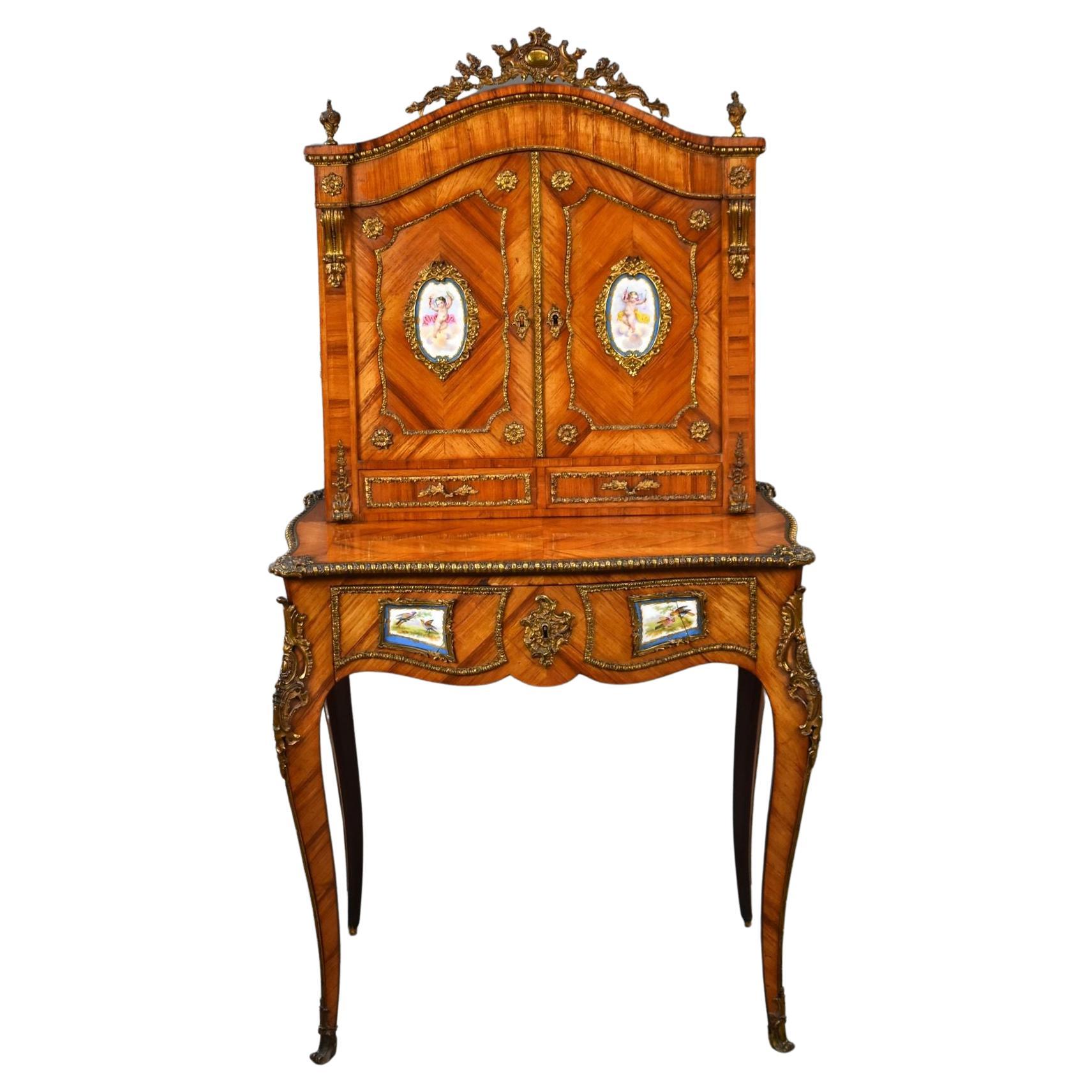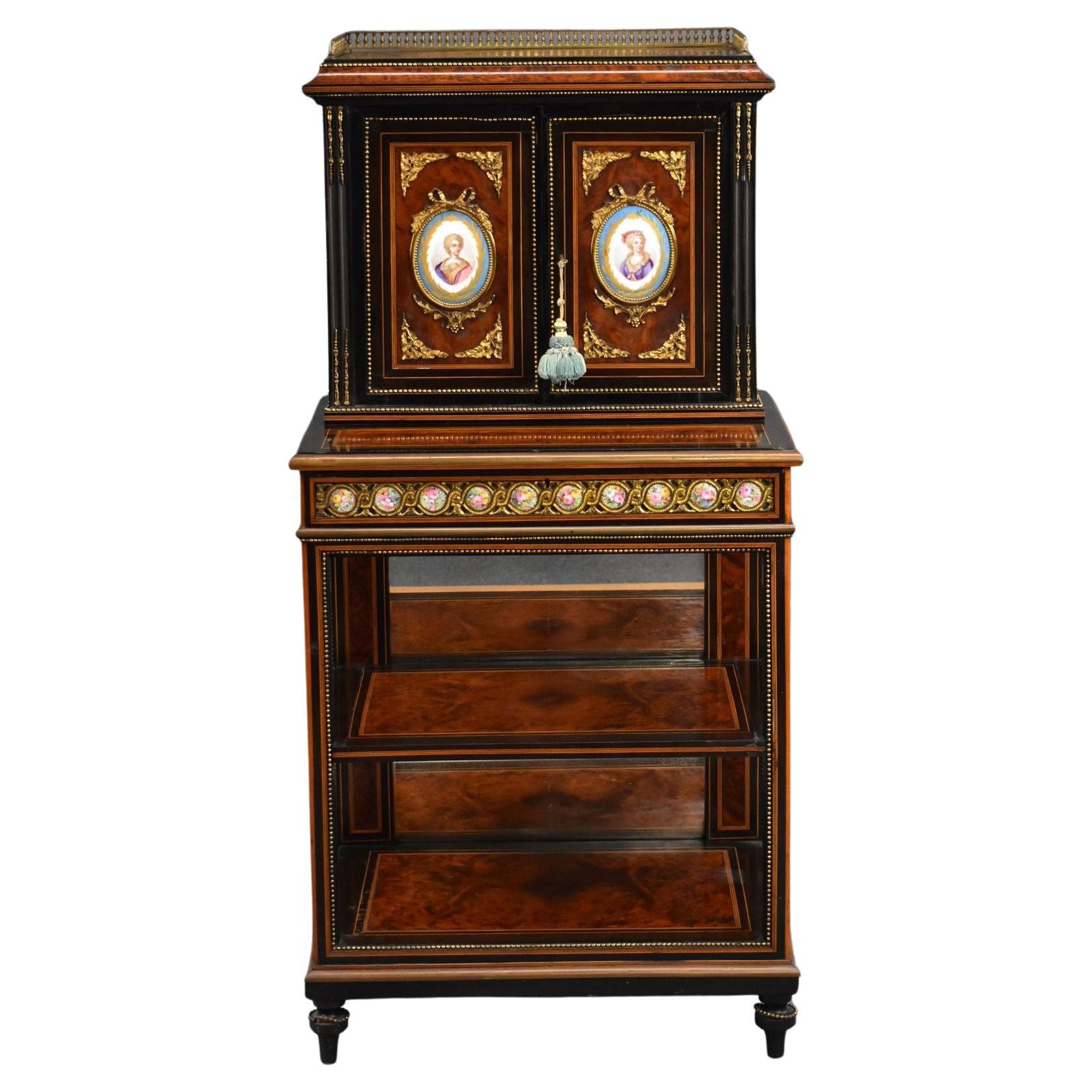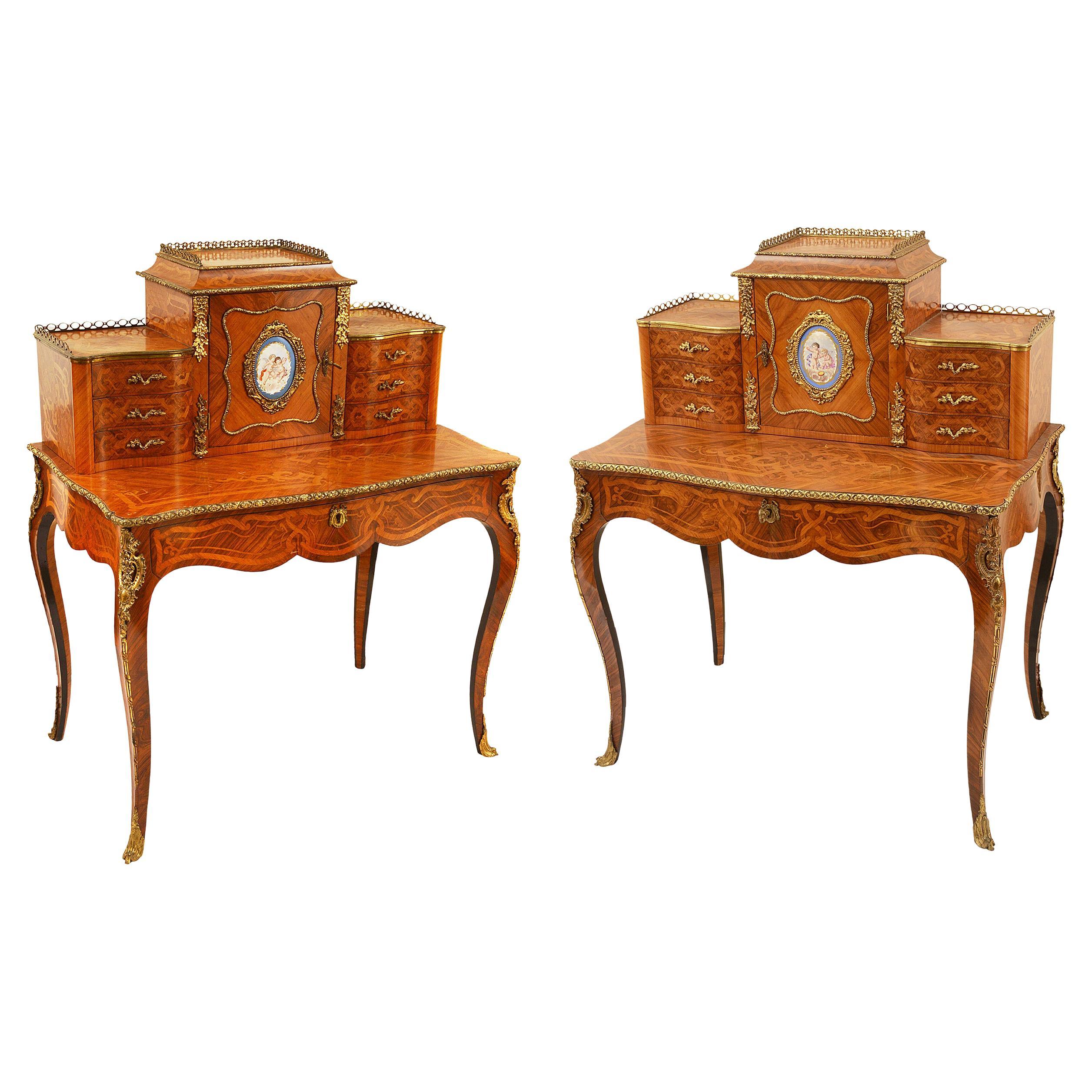Items Similar to Exceptional Regency Bonheur Du Jour Attributed to John Maclean
Video Loading
Want more images or videos?
Request additional images or videos from the seller
1 of 13
Exceptional Regency Bonheur Du Jour Attributed to John Maclean
About the Item
An exceptional English Regency-period bonheur du jour attributed to John Maclean, ca 1810.
A Fine early 19th century rosewood and brass-inlaid bonheur du jour or writing desk, of the highest quality.
Of lovely color and patina. In superb condition throughout.
John Mclean (born 1770, died 1825) was an English furniture- and cabinet-maker and designer. He was recognised as one of the best of his era, representing the best in English cabinet making. Examples of his furniture can be found in the Victorian and Albert Museum, The California Palace of the Legion of Honor and the Library at Saltram, Devon.[1]
The origins of the McLean firm is somewhat confused by the many variations in spelling the name 'McLean'. "John MacKlane, upholder and cabinet maker in Little Newport Street, off Leicester Square" is listed in 1774.[2]
Refs:
^ "Sale of exceptionally Rare Regency Brass-Mounted Rosewood Table". Thomas Coulborn & Sons.
^ Jump up to: a b The London furniture makers: from the Restoration to the Victorian Era, 1660-1840.
^ Jump up to: a b c Simon Redburn, John Mclean and Son, Furniture History.
^ "Fine Regency Gilded & Gilt Brass Rio Rosewood Canterbury by John McLean & Son - Freshfords Fine Antiques". Retrieved 2017-03-05.
A bonheur du jour (French, meaning "daytime delight") is a type of lady's writing desk. It was introduced in Paris by one of the interior decorators and purveyors of fashionable novelties called marchands-merciers about 1760, and speedily became intensely fashionable.[1] The bonheur du jour is always very light and graceful,[2] with a decorated back, since it often did not Stand against the wall (meuble meublant) but was moved about the room (meuble volant); its special characteristic is a raised back, which may form a little cabinet or a nest of drawers, or open shelves, which might be closed with a tambour, or may simply be fitted with a mirror. The top, often surrounded with a chased and gilded bronze gallery, serves for placing small ornaments. Beneath the writing surface there is usually a single drawer,[2] often neatly fitted for toiletries or writing supplies. Early examples were raised on slender cabriole legs; under the influence of neoclassicism, examples made after about 1775 had straight, tapering legs.
Nb. A very similar bonheur du jour also attributed to John Maclean was sold at 'Tom Devenish: The Collection - Highly Important English Furniture', Sotheby’s, New York, 24th April 2008 lot 176 for US$37,000.
An English Regency period brass-mounted library table attributed to John Maclean was sold by Christies, 18th June 2008, for £109,250.
Vis. A Life's Devotion: The Collection of the Late Mrs T.S. Eliot. Christie's London, 20 November 2013. A Regency brass-mounted rosewood side table - attributed to Maclean, ca 1810 - Price realised: £20,000.
Literature:
See S. Redburn, John Mclean and Son, Furniture History, (1978) plate 38A, for a comparable chevret table, formerly at Lowther Castle. See also Christie's, London, 7 December 1971, lot 67, for an unattributed chevret table of the same model but with various differences in the marquetry and design.
The firm of McLean and son was established in London around 1770, trading from premises in Little Newport Street, Leicester Square, until 1783. By 1790 the firm had moved to 55 Upper Marylebone Street, later expanding to occupy premises in both Pancras Street and Upper Terrace and continuing in business until 1825. Cabinet-makers of the highest calibre, patronised by such leading connoisseurs as the 5th Earl of Jersey, for whom they worked extensively at Middleton Park, Oxfordshire, and the Earl's London mansion in Berkeley Square.
In Thomas Sheraton's, The Cabinet Dictionary of 1803, McLean and sons are listed among the foremost English cabinet-makers of the period, and it is some indication of the esteem in which they were held that Sheraton himself made use of one of their designs for a 'pouch table', which he illustrated in the Dictionary, (pl.65), remarking that, 'The design... was taken from one executed by Mr M'Lean in Mary-le-bone street, near Tottenham court road, who finishes small articles in the neatest manner''.
- Dimensions:Height: 41.93 in (106.5 cm)Width: 28.35 in (72 cm)Depth: 18.31 in (46.5 cm)
- Style:Regency (Of the Period)
- Materials and Techniques:
- Place of Origin:
- Period:
- Date of Manufacture:circa 1810
- Condition:Wear consistent with age and use. Of lovely colour and patina. In superb condition throughout.
- Seller Location:Lymington, GB
- Reference Number:
About the Seller
5.0
Vetted Seller
These experienced sellers undergo a comprehensive evaluation by our team of in-house experts.
Established in 1957
1stDibs seller since 2018
33 sales on 1stDibs
Typical response time: 8 hours
- ShippingRetrieving quote...Ships From: Lymington, United Kingdom
- Return PolicyA return for this item may be initiated within 14 days of delivery.
More From This SellerView All
- Fine Rare Regency Cellarette or Jardinière Attributed to Thomas HopeBy Thomas HopeLocated in Lymington, GBA fine and rare cellarette - or jardinière - attributed to Thomas Hope, ca 1810. In the best quality mahogany with ebony lines and raised on well-carved animal paw feet. Original zinc...Category
Antique Early 19th Century Regency Planters and Jardinieres
MaterialsMahogany
- Fine Chippendale Period Satinwood and Marquetry DeskLocated in Lymington, GBA fine Chippendale-period satinwood and marquetry desk. English, George III period, circa 1770. The considerable use of the best quality mahogany in the carcass is typical of the very fine work of Thomas Chippendale. It is rare today to find an 18th-century satinwood and marquetry-inlaid desk of this quality. (Most offered on the market are 19th/ 20th century). Major, period satinwood pieces have become almost unobtainable. The superbly-controlled and delicate marquetry inlays are reminiscent of the fine decoration on the famous Diana and Minerva Commode by Chippendale at Harewood House...Category
Antique 18th Century English George III Desks
MaterialsSatinwood
- Small George I Walnut Bureau on StandLocated in Lymington, GBGeorge I period walnut bureau or desk on stand, of compact proportions, ca 1720. This small early Georgian desk is veneered in walnut an...Category
Antique Early 18th Century English Georgian Desks
MaterialsWalnut
- George I Walnut Secretaire Kneehole DeskLocated in Lymington, GBAn English early 18th century walnut secrétaire kneehole desk. George I period (1714-1727), c 1720. Of exceptional waxed honey color and lovely old patina, with well-matched veneers. With a quarter-veneered top. Six short drawers below a hinged fall revealing a writing section, all surrounding a central recessed cupboard. There is a small, shaped pull-out drawer fitted in the apron. All finely inlaid with herringbone lines. Raised on its original bracket feet. Swan-neck handles probably fitted later in the 18th century. Locks and keys are mostly original. Walnut veneered and crossbanded sides. Nb. Having a fitted secrétaire drawer distinguishes this antique walnut kneehole desk...Category
Antique Early 18th Century English George I Desks
MaterialsWalnut
- Pair Regency Period Bronzed Giltwood TorchèresLocated in Lymington, GBA fine and rare pair of English Regency period torchères, or stands (or candle stands) in the manner of Thomas Hope. Circa 1810. Both are raised on tapering simulated-bronze column supports with circular tops and fluted gilt collars, on concave-sided triform bases with winged-panther mask monopodia. The column bases issue from spreading, gilded, carved lotuses. These antique torcheres might also be referred to as columns, ornamental stands, candle sticks, or candelabra. In superb condition throughout. Literature: ‘Thomas Hope – Regency Designer’ ed. David Watkin & Philip Hewat-Jaboor, Yale University Press, New Haven and London (2008). The Aurora Room, Duchess Street, photo from V & A Museum, fig. 68-1, p. 378. The Royal Collection, HM Queen Elizabeth II, RCIN 588- 1-2, 45- 1-2, figs. 78-2, 78-3, p. 396. The Faringdon Collection, Buscot Park, Oxfordshire, illustr. 88, p. 414. The pair of stands we are offering here correspond closely to the pair in the Faringdon Collection (see above). Watkin and Hewat-Jaboor state; ‘’A ‘Roman’ stand of this precise design, perhaps an imaginative variation on one published by Visconti*, is illustrated in ‘Household Furniture’, plate L, number 2… Hope also owned several classical Roman candelabra...Category
Antique Early 19th Century English Regency Candlesticks
MaterialsGiltwood
- Fine Regency Mahogany Library Centre TableLocated in Lymington, GBA fine Regency period tilt-top brass inlaid mahogany and calamander library center table. Raised on a concave-sided triform base, with well-modelled cast-brass scrolling feet. Also referred to as a monopodium (table). All in excellent condition, well figured, and of very good rich color. Typical of designs by Thomas Hope (1769 - 1831). This form of antique table is also associated with work by George Bullock (1777 - 1818) and George Oakley (circa 1765 - 1841). Refs: A similar table with a leather insert, in the manner of Thomas Hope, circa 1800 - 1805, was sold in London for £39,650 - December 2010. This early 19th century table is reminiscent of the ‘Grecian’ style that the pioneering collector and designer Thomas Hope (1769-1831) popularized in Britain with the publication of ‘Household Furniture and Interior Decoration’ in 1807. Thos. Hope (banker, born 1769, d. 1831) The furniture manufacturer George Oakley (circa 1765-1841) was greatly influenced by Hope’s designs, and produced fashionable furniture in this style, using brass and star inlays similar to our table on offer. The firm’s designs and craftsmanship earned them royal patronage, and Oakley worked for the Prince Regent at Carlton House, as well as supplying furniture and upholstery for The Mansion House and The Bank of England. His work for the Cheere family - of Papworth Hall, Cambridgeshire, UK - is well documented. The reference to Geo. Oakley relates to a known table of this pattern in calamander wood and brass marquetry of starred-ribbon guilloche, which corresponds to the brass marquetry in a table supplied by Oakley in 1810 to Papworth Hall. Lit: Parker, R. 'History of Papworth Everard...Category
Antique Early 1800s English Regency Center Tables
MaterialsMahogany
You May Also Like
- 19th Century English Bonheur Du Jour Attributed To Gillows Of LancasterBy Gillows of Lancaster & LondonLocated in Dublin, IEA very fine 19th century Burr walnut, ebonised , ormolu and porcelain Bonheur du jour, the superstructure with pierced brass galleries above an open compartment with mirrored interio...Category
Antique 19th Century English Victorian Desks
MaterialsOrmolu
- Regency Burl Elm Bonheur De JourLocated in Essex, MAWith rectangular shelf superstructure with two shelves and three drawers with ebony trim , the base with a flip up writing surface thats felt lined over a drawer and raised on square...Category
Antique Early 19th Century English Regency Desks
MaterialsElm
- 19th Century French Bonheur Du JourLocated in Chelmsford, EssexFor sale is a fine quality 19th century ebony and Thuya wood Bonheur Du Jour. The bonheur du jour has a brass gallery around the top, above a central mirror...Category
Antique Mid-19th Century French Desks
MaterialsEbony, Amboyna
- 19th Century Walnut Bonheur Du JourLocated in Chelmsford, EssexFor sale is a good quality 19th Century French walnut Bonheur Du Jour with ormolu mounts and sevres plaques. With an upper arched section with pierced rococ...Category
Antique 19th Century French Desks
MaterialsWalnut
- 19th Century French Bonheur Du JourLocated in Chelmsford, EssexFor sale is a French 19th century Amboyna and Ebony Cabinet, with three quarter balustrade gallery, above two panelled doors set with Paris porcelain po...Category
Antique 19th Century French Desks
MaterialsAmboyna
- Pair 19th Century Bonheur Du JoursLocated in Brighton, SussexRare pair of 19th Century French Kingwood and Tulip wood veneered Bonheur du jours, each with pierced three quarter brass galleries, gilded ormolu mounts, three drawers either side o...Category
Antique 19th Century Japanese Louis XVI Desks
MaterialsPorcelain, Mahogany
Recently Viewed
View AllMore Ways To Browse
London Used Furniture
Antique Furniture History
New Regency
Important English Furniture
New England Cabinet
English Attributed
Desk Upper Cabinet
Late Regency Period Furniture
Regency Era Furniture
Small Desk Light
Street Light Antique
Antique Street Light
Early 18th Century New England
Expandable Cabinet
English Regency Neoclassical
Desk Cabinet With Mirror
Desk With Wall Storage
Desk Side Shelves





